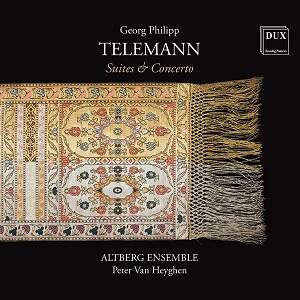
Georg Philipp Telemann (1681-1767)
Ouverture-Suite in D major, TWV 55: D18
Ouverture in A minor, TWV 55: a4
Concerto Polonois in G major, TWV 43: G7
Ouverture in D major, TWV 55: D23
Altberg Ensemble/Peter Van Heyghen
rec. 2021, Nowa Miodowa, Warsaw, Poland
DUX 1761 [69]
Such was the prolific number of Telemann’s compositions that the four works on this disc, like much of his output, probably rarely cross the radar of any but the composer’s most committed listeners. Although they do not have any distinguishing nicknames, these particular pieces contain characteristic dances and movements in French and Polish styles that capture the attention, especially in these refined and idiomatic performances by Peter Van Heyghen and the Altberg Ensemble.
The grand opening movement of the Ouverture-Suite sounds like Handel in ceremonial form, if a touch more foursquare. But its buoyant articulation, with a slight staccato tread to the notes, even before the strings’ scurrying semiquavers, ensure that the music has zest and dynamism here, rather than flabby grandeur, despite impressively reverberant timpani and two crisply resplendent natural trumpets. Thereafter the Altberg Ensemble imbue the music with an irresistibly French, galant character not least in the lightly brisk pair of Minuets – where there are delicious harmonic clashes between the trumpets and violins on the execution of the appoggiaturas in the melody – and the Passacaille, in the style of Lully, with the strings’ rustling semiquavers remaining transparent and not burdening the texture. The CD notes rightly compare the Air with the famous equivalent example from Bach’s Orchestral Suite No. 3, with its similarly long-spun melody for violins over softly held chords, even if the movement overall is shorter. The imitations of postman’s trumpets in ‘Les Postillions’ and the concluding Fanfare again bring out the best in the two trumpeters.
In the Ouverture in A minor, for pairs of recorders and oboes, bassoon, and strings, the ensemble successfully articulate the music with an even more typically French accent, by decorating the melody with trills, or passing notes or appoggiaturas between the principal notes. The fast section of the first movement proceeds robustly and implacably as all the parts move along in dotted rhythms, whilst the recorders and oboes fairly chirrup away in the central section of the Passepied – described in the notes as a ‘bird’ trio. In such dance movements Van Heyghen sensibly rings the changes by having different combinations perform in the repeats to create timbral contrast.
A pleasing swing characterises the Polonaise of that Ouverture, introducing the national style that comes to the fore in the disc’s third work, the Concerto Polonois, for strings alone rather than with a solo instrument. Only its third movement is actually headed ‘polonaise’; the others are given generic tempo markings. But all four feature typical Polish elements – even if, in reality, that perhaps means a general rustic vigour that might not have been confined entirely to Poland’s musical practices alone. Drone effects, sharpened fourths and flattened seventh in the melodies to unsettle the main key, and striking juxtapositions of tonalities all feature, but the Altberg Ensemble take them in their stride as they proceed through the work with an earnest vitality that does not render the music crudely stereotypical or caricatured.
Another Ouverture in D major concludes the disc, also very French in both Telemann’s writing and the polished performance here, with rippling flutes in the first movement which the notes liken, in its structure and style, to Rameau. Indeed, this whole suite of dances could be a compilation of such interludes from his operas, and the ‘Plainte’ movement sounds like the instrumental version of a vocal lament from such a work. The second Minuet is particularly charming with its graceful dialogue between the two flutes, over gently repeated quavers in the strings, performed here with all the delicacy of a Watteau painting. The lightly rasping horn of the Fanfare brings a joyful dash to the end of this work and the CD overall.
The lovely ambient acoustic throughout the disc gives the music space – particularly important in the first D major Suite – without too much echo. This is a wonderful release, constituting a stylish addition to the Telemann discography, and self-recommending for fans of the composer. But it will also provide rewarding listening for those who regret that Bach did not write any more than his four Orchestral Suites and seek more such repertoire. It is a record I look forward to returning to many times over.
Curtis Rogers
Help us financially by purchasing from





















